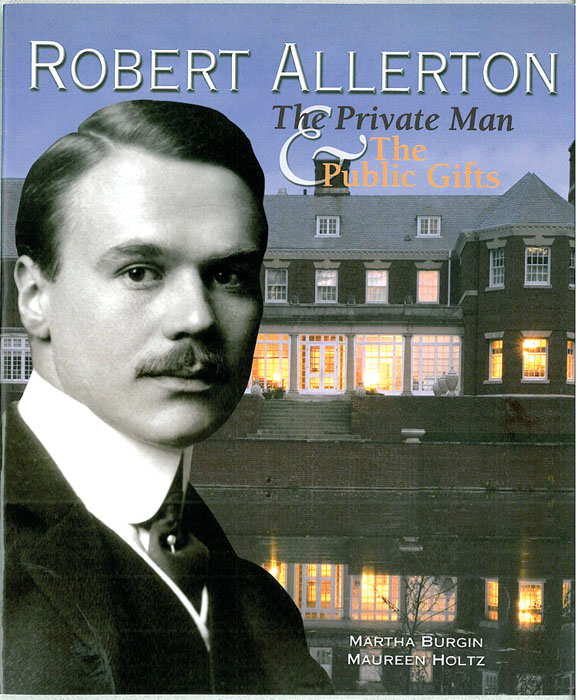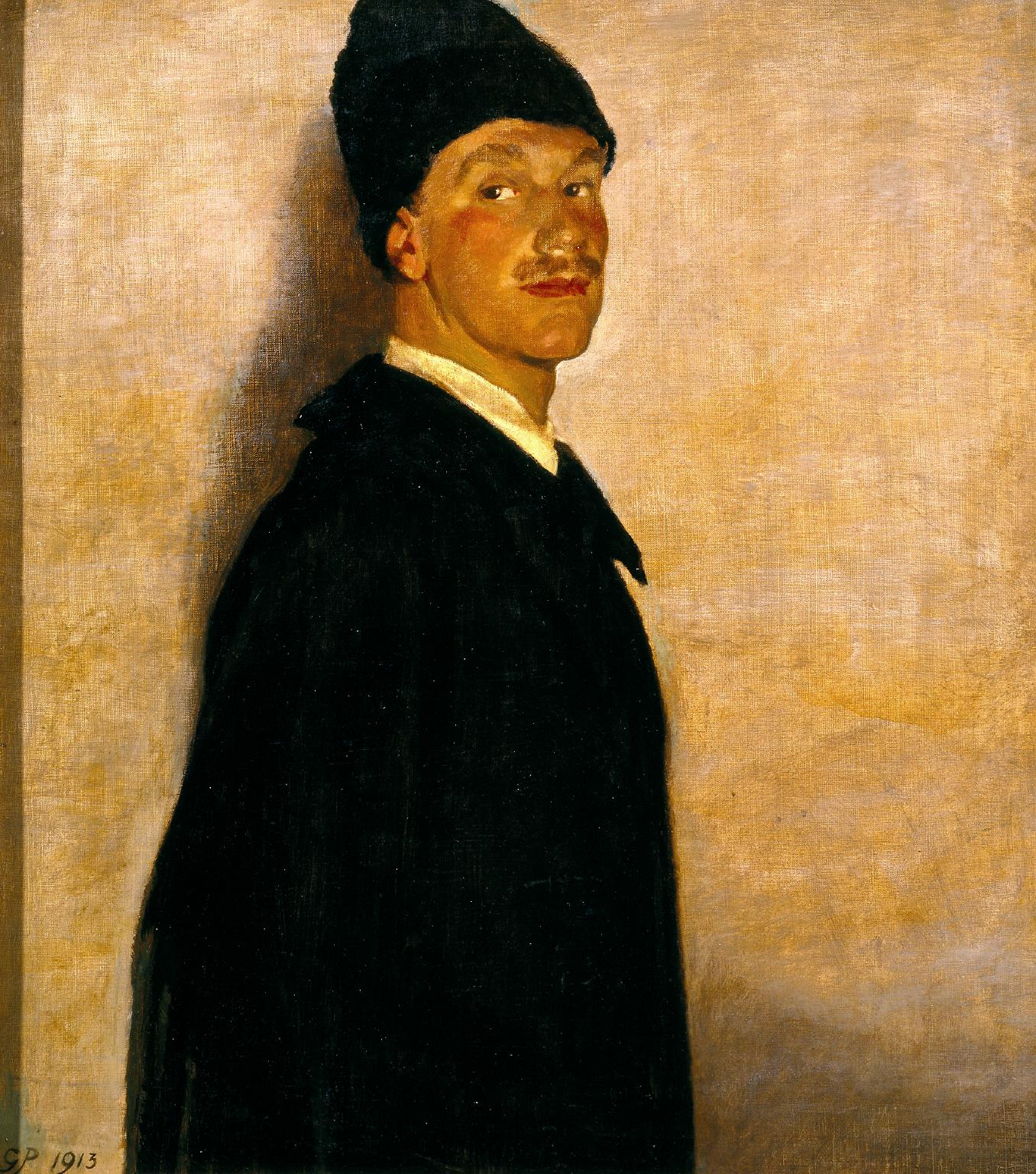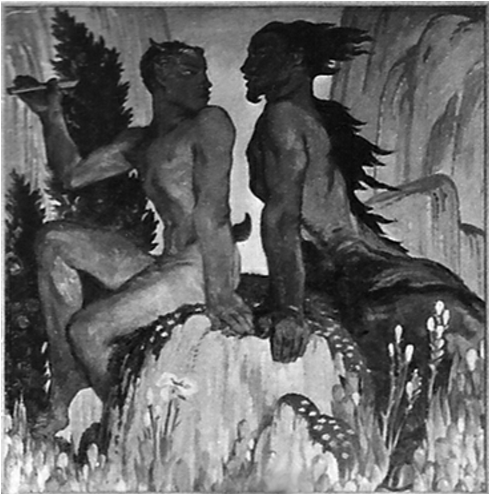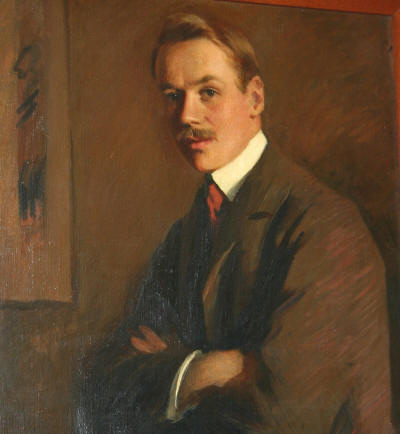

Partner John Borie, Charles Russell Hewlett, Roger Quilter, Glyn Philpot, John Gregg
Queer Places:
Prairie Ave, Chicago, IL, Stati Uniti
The Farms, Robert Allerton Park, 515 Old Timber Rd, Monticello, IL 61856, Stati Uniti
Allerton Garden, 3530 Papalina Rd, Kalaheo, HI 96741, Stati Uniti
 Robert Henry Allerton (March 20, 1873 – December 22, 1964), born in
Chicago, Illinois, United States, was the son and heir of First National
Bank of Chicago founder Samuel Allerton.[1]
A philanthropist for most of his life, he left Allerton Garden, the
Honolulu Academy of Art, the Art Institute of Chicago, and Robert Allerton
Park as legacies for the public to enjoy.
Glyn Philpot’s Portrait of a
Man in Black (1913) depicts
Robert Allerton, his then lover, as does
Duncan Grant’s painting of
John Maynard Keynes
(1908). These works show remarkable intimacy, and informed interpretations
of the works are not possible if a viewer is ignorant of the sexual
relations between the men. This is not a concession to prurient interests,
but important art historical data similar to that commonly provided when
the artist is known to have been heterosexual.
Robert Henry Allerton (March 20, 1873 – December 22, 1964), born in
Chicago, Illinois, United States, was the son and heir of First National
Bank of Chicago founder Samuel Allerton.[1]
A philanthropist for most of his life, he left Allerton Garden, the
Honolulu Academy of Art, the Art Institute of Chicago, and Robert Allerton
Park as legacies for the public to enjoy.
Glyn Philpot’s Portrait of a
Man in Black (1913) depicts
Robert Allerton, his then lover, as does
Duncan Grant’s painting of
John Maynard Keynes
(1908). These works show remarkable intimacy, and informed interpretations
of the works are not possible if a viewer is ignorant of the sexual
relations between the men. This is not a concession to prurient interests,
but important art historical data similar to that commonly provided when
the artist is known to have been heterosexual.
Robert Henry Allerton enjoyed traveling to countries around the world. In these countries he would buy statues of all kinds, which were then placed in his estate. Most of the statues are no longer on the estate, now called Robert Henry Allerton Park, but there are still a few left.
Robert Henry Allerton was born on March 20, 1873, as the second child and only son to Samuel Waters Allerton (1828–1914) and Pamilla Thompson Allerton (1840–1880). Through an entirely paternal line, Robert Henry Allerton was descended from Isaac Allerton, an English Puritan who came to America on the Mayflower in 1620.[2] Samuel Allerton was a self-made man who made his millions in land, livestock, banking, and other commercial enterprises. Pamilla Allerton died in 1880, five days before Robert's 7th birthday. Two years later, Samuel Allerton married Agnes Thompson, Pamilla's younger sister. Agnes Thompson Allerton (1858–1924) became mother, friend, and cultural mentor for her stepson/nephew. She kindled his interests in literature, music, gardening, and above all, visual arts.

Robert Allerton by Glyn Warren Philpot

Faun and Satyr over-mantle, The Farms, by Glyn Philpot

Robert Allerton by Ellen Emmet Rand
The Allertons lived on Prairie Avenue in Chicago, which was the most fashionable residential street in that city in the 1800s. The Allertons were neighbors of Marshall Field, the Pullmans, Kimballs, and Armours. Robert attended Allen Academy and Harvard School in Chicago, after which he and friend Frederic Clay Bartlett, were sent east to St. Paul's School, a prestigious college prep school in Concord, New Hampshire. The young Chicagoans decided not to go on to college, but rather to study art in Europe.
The origins of Robert Allerton's almost rabid aestheticism can be traced to the Chicago Columbian Exposition of 1893, at which he and a close boyhood companion, Frederic Clay Bartlett, were bedazzled by the fair's transformative splendors of architecture, sculpture, painting - and Bavarian beer. Both were the sons of rough and tumble frontier millionaires, but they aspired to escape their seemingly predestined careers in business by pursuing art training in Europe, pledging their lives (as Bartlett recalled) "to the creation of beauty." While Paris would be their ultimate destination, the two young men first received training in Germany during the winter of 1893-1894, which proved sufficient to gain them admission to the Royal Academy of Fine Arts in Munich (then second only to the salons of the French capital for excellence and rigor). Two years later, they realized their dream and relocated to Paris, where they continued their preparation at a number of different studios, including the Ecole Collin, the Aman-Jean School of Painting, the Academie Colarossi, and the Academie Julien. But while Frederic Clay Bartlett would return to Chicago and achieve a modest renown as a painter and muralist, Allerton suffered a kind of aesthetich breakdown in Paris (perhaps recognizing the limits of his creative skill); in December 1897, he destroyed all of his sketches and canvases, renounced his artistic ambitions and returned to the USA to assume the life of a gentleman-farmer.
From late autumn through the following spring of 1898–1899, John Borie toured the English countryside as the guest of his new patron, Robert Allerton, soon to be dubbed the “Richest Bachelor in Chicago.” Together they hoped to find inspiration for the magnificent house and garden estate that this scion of a stockyard-and-banking tycoon wanted to build among the vast acres of farmland that his family owned near the town of Monticello in central Illinois.
When the two young men sailed from New York on the S. S. Campania in October 1898, Allerton first was inclined to favor a Tudor prototype for his new mansion; but by the time they returned in March 1899, he and Borie had settled upon a Stuart model, Ham House (dating from 1610), overlooking the Thames in Surrey. The final plans modified this prototype with obvious Georgian influences (such as a tall parapet to conceal the roofline), but the blueprints also carried the professional stamp of James Gamble Rogers, a fellow architect who had worked with Borie at Cope and Stewardson in Philadelphia and since had established his own practice in Chicago. Construction at Monticello began immediately in the summer of 1899, and the main house essentially was completed the following year. Borie’s complementary designs for a series of enclosed garden spaces (which, eventually, would “stretch for miles”) took shape in the ensuing years, as several additional outbuildings also were constructed and modifications made to the central mansion itself, to accommodate Allerton’s rapidly growing collection of precious furniture, tapestries, porcelain, sculpture, and other works of art.
Most sources presume that Borie and Allerton struck up their friendship in Paris, since both were there in 1896; probably, they circulated among overlapping cadres of expatriate artists and likely would have felt a certain kinship as aspiring Bohemians. Their paths may have crossed before, however, as Dickie Borie already had connections in Chicago: in 1889, his older sister Emily Maria Borie had married another mid-western millionaire, Arthur Larned Ryerson, which might have given him pretext for visiting the windy city and socializing with its most privileged echelon.
Not long after work on “The Farms” was begun at Monticello in 1899, Allerton and Borie again departed for Europe and the Near East. Their mission now was to begin acquiring the exquisite furnishings and works of art needed to embellish and ornament the extraordinary house that was fast rising on the prairie.
An unexpected feature of the house surely was the pair of sphinxes that Borie had designed to adorn the stairway leading from the terrace down to the lake and gardens beyond Possibly, the architect’s inspiration for these strangely androgynous figures came from an embossed image on the cover binding of the eponymous poem, The Sphinx, published by Oscar Wilde in 1894. Tellingly, that design had been executed by another Edwardian bachelor/aesthete, Charles Ricketts, who lived openly with his partner, Charles Shannon, for all of his adult life. Over the years, works by some of Allerton's other gay friends and lovers would be added to different garden rooms at Monticello, most notably the Primitive Man sculptures, done in 1921 by the English artist Glyn Philpot, who relied on the nude modeling of his host's butler to accomplish their design.
Ellen “Bay” Emmet returned to New York in 1900, and wrote to a friend that she had gone to the opera with a man fitting Robert Allerton's description, and that she had agreed to paint his portrait. In the late spring of the next year, she arrived in Chicago, where she completed an imposing canvas of Allerton's father (which for many years hung in the Board Room of the First National Bank, of which he was chairman), before coming to "The Farms," where her other commission, on a somewhat smaller scale, awaited her. A bond of possibly romantic friendship seemed in the offing. Also present, however, was John Borie, who was still drawing up plans for the as-yet-unfinished interior of the main house and attending to the construction of gardens and outbuildings on the estate. From a patchwork of letters that survive, it seems that the intrusion of a woman (and an aesthetic woman at that) profoundly disrupted relations between the two men, who now began to quarrel about details great and small. By summertime, Bay Emmet had retreated to New York, where she shuttled between her studio in Washington Square and a country retreat upstate, where more commissions were at hand, including one for a portrait of Emily Borie Ryerson, whose family had just built an enormous summer house (“Ringwood,” also designed by her brother) in Springfield Center, at the northern end of Lake Otsego. But the flare-up at “The Farms” followed Bay there and so did John Borie, who clearly was dividing his attention between the Allerton project and his sister’s estate, where extensive work on formal landscape gardens had begun now that the main house was finished.
Jane Emmet de Glehn’s acquaintance with Robert Allerton and John Borie was first made in Paris in 1897, and it grew more intimate after all of them had returned to the USA. Later, when Dickie Borie moved from Philadelphia to New York City in 1902, there was no shortage of occasions for that pair to extend their friendship.
Work on “The Farms” was hardly completed when John Borie moved his office to New York; he continued to send blueprints back to Monticello as the estate gradually took shape, and it is likely that he himself would have had occasion to return, from time to time, to oversee new construction and the implementation of his designs. Whatever the source of the friction that had disturbed Borie’s relationship with his client during the first phases of construction, Robert Allerton nevertheless nevertheless retained the architect’s services for at least another dozen years. Travelling in the other direction, Allerton made regular stops in New York, as the port of departure for his (almost annual) trips abroad during the winter months, when he scoured the cities of Europe, the Middle East, and the Orient, acquiring new pieces for his ever-expanding collection of sculpture, furniture, and objets d'art. On one of these visits in 1905, he was invited to spend Thanksgiving up in Connecticut with the Emmets. Bur if there was any hopeful residuum of romance between Allerton and Bay, the young man's immediate plans would have cast a pall upon it, as he was about to embark on an around-the-world cruise with Charles Russell Hewlett, another bachelor-connoisseur, who would travel as his guest companion.
Earlier in 1907, the von Glehns' salon opened its doors to Robert Allerton, as he was passing through London on another of his wintertime sprees of acquisition. Besides commissioning Wilfrid de Glehn to design a decorative panel for an overmantle at The Farms, Allerton clearly was keen on meeting other artists in the von Glehns' circle. Tonight Percy Grainger is going to have some of his choruses rehearsed here in the studio," Jane scribbled home. "Victor Beigel (John Borie's new partner, n.d.r.) is supplying some singers. John Singer Sargent is coming."
Besides accumulating an ever-expanding collection of art for his country estate, Allerton also assembled an astonishing wardrobe of fantastic costumes—kimonos, cloaks, togas, hats and headdresses, shoes and sandals, as well as costume jewelry and other accessories—that became obligatory apparel for his summertime guests, permitting them “to discard societal conventions and become whoever, whatever, their fantasies could conjure.” So extensive was this campy collection that in 1912 John Borie returned to The Farms with plans to repurpose the estate’s large greenhouse (flanking the stable) as a kind of oversized wardrobe-and-changing room, linked to the main house through a newly redesigned entranceway, the Marble Hall.
Allerton began inviting (or attracting) young male artists to stay with him at Monticello, perhaps thinking of The Farms as a kind of one-man MacDowell colony, where quietude and devoted companionship would prove amenable to the Muse. One of the first intended guests was the English composer Roger Quilter, to whom Allerton was introduced at the von Glehns' salon in the winter season of 1910-1911. Their relationship soon intensified - it would be the only homosexual one to which Quilter ever admitted - and Allerton implored his new lover to stay with him at The Farms in the coming summer months. "I want to go very much," Quilter revealed to Percy Grainger (another confidant - and possibly bel ami), "& yet I hate the idea of the journey - & I don't want to be away from you for very long." In the end, Quilter never followed Allerton to Monticello; their affair was short-lived. But it must have left a deep impression, for more than a decade later (in 1928), Quilter dedicated a new composition to Robert Allerton: a complex scoring (for tenor voice and piano) of one of Shelley's most ardent lyrics, "I Arise from Dreams of Thee."
Robert Allerton frequently accompanied John Sumner Runnells' unmarried daughter, Alice, to the theater and other social events, and he enjoyed the Runnells' hospitality at Willowgate, in Chocorua, New Hampshire, near the home of William James (Henry James' brother). By 1911, Alice Runnells had become engaged to young William "Billy" James, second son of William and Alice James, an aspiring painter who had often asked her to sit for him in his time at Chocorua. Perhaps disappointed that Roger Quilter failed to join him that summer at The Farms, Allerton followed the Runnells to Willowgate and discovered that the James' youngest child, Alexander Robertson James, then not quite 21, also was determined to become a painter of note. Having apprenticed himself to Abbot Thayer in that artist's Dublin, New Hampshire, studio for several years, Aleck now wanted more formal training and, following his brother Billy, had gained admission to the School at the Museum of Fine Arts in Boston. When their time in the north country was up, Allerton offered to escort young James back to the city. Allerton's interest in young Aleck extended at least through the following summer, when, in keeping with the pattern already established, the aspiring painter was invited to stay at The Farms. Aleck was on his way west to experience the frontier life of a dude ranch in Montana, but, at Allerton's request, he first stopped at Monticello in June 1912. While in residence there, Aleck completed a charcoal sketch of his host, now lost, striking enough to impress his uncle Henry James, to whom it was dispatched.
After meeting the English painter Glyn Philpot at the Covent Garden opera house in the spring of 1913, Allerton invited him to stay with him later that summer. Philpot eagerly accepted the invitation, but when he disembarked from his steamer in New York that August, he was greeted not by his host but instead by some other mutual friends who informed him that Allerton was then entertaining John Borie at The Farms, as he had the previous summer. Miffed by this unexpected development, Philpot crudely villified his rival, whom he seemed already to know. "Borie - that beast," he ejaculated. But when Philpot finally made his way to Illinois, the painter had access to a magnificent studio where he finished, among other works, a striking canvas, The Man in Black - for which Robert Allerton seems to have posed in one of his many exotich costumes. In the letters, he wrote back to England (especially those addressed to his utterly devoted sister, Daisy), Philpot announced that he was extending his stay at Monticello and implicitly acknowledged his homosexual attraction to his generous host.
Although The Man in Black was purchased for the Tate Gallery in London the following year, Philpot left his artistic mark at the Farms with his later garden sculptures and an interior over-mantle that depicts Allerton as a lustful Roman faun, staring into the eyes of a satyr: in this queer allegory, both muscular nudes sprout budding horns and flowing manes, unmistakable emblems of male virility and sexual appetite.
In 1922 he met John Gregg (1899–1986), an orphan and aspiring architect, who after the stock market crash of 1929, came to live with Allerton. He was to become his lifelong companion. After a change in Illinois law in 1959, he legally adopted Gregg as his son. After their deaths, Allerton and Gregg's mingled ashes were scattered on Lawai Bay, Kauai, Hawaii.
Allerton's estate began in 1897 when Allerton decided to become a farmer. By 1914 his "farm" had grown to over 12,000 acres and became known as "The Farms".[3] Now called Robert Allerton Park, it is owned and operated by the University of Illinois near Monticello, Illinois. The botanical journal Allertonia and the two estate parks are named after Robert Allerton. The main building of the Art Institute of Chicago, where he served as the honorary president and trustee, was renamed the Allerton Building in his honor in 1968.
The former Hawaiian Royal tropical estate, located on the island of Kauaʻi in Hawaiʻi, is now called the Allerton Garden. After John Gregg Allerton's death it became part of the National Tropical Botanical Garden, with public tours.
My published books: